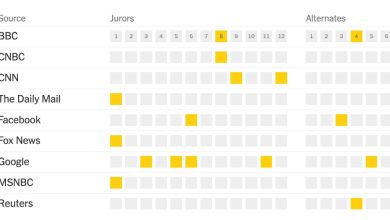An Unprovoked Killing Leaves a Void in a Bronx Neighborhood

In an apartment in the Norwood neighborhood of the Bronx, Sahyeedah Belis sat on her bedroom floor, Nike Air Jordan shoe boxesneatly packed with pay stubs arrayed next to her outstretched feet.
The meticulously stored documents, 15 years of them, were a glimpse into the well-ordered life of her fiancé, Nathaniel Rivers — a man who scrubbed his hands and trimmed his nails so often that it was impossible to know from his perfect manicure that he worked most of his life as a carpenter. A man who, when he mounted a basketball hoop in front of the apartment building outside so children could play, thought to chain it in place.
As Ms. Belis sat, looking at a bedroom wall lined with pictures of Mr. Rivers, she tried to understand how a man who planned almost every detail of his life could have been stabbed to death in July in a random eruption of violence.
“My soul got snatched,” Ms. Belis said, choking back tears.
The Bronx attack, which police officials and Mr. Rivers’s family said was unprovoked, echoed notorious murders in Manhattan this year, in which victims were merely going about their routines when they were attacked in unexpected places and for inexplicable reasons.
Michelle Go, 40, was pushed onto subway tracks in Times Square in January by a man found unfit to stand trial because of mental illness. In May, Daniel Enriquez, 48, was shot to death while taking the Q train to brunch by a man who suffered from mental illness, the victim’s family said. And the stabbings of three homeless men in Manhattan, one fatally, ended in the arrest of a 40-year-old whose family said suffered from mental illness.
But as those widely covered attacks drove discussions about crime and the state of a city reviving as the coronavirus pandemic receded, news of Mr. Rivers’s death quickly faded outside Norwood, a residential neighborhood tucked just north of the New York Botanical Garden and anchored at the center by Williamsbridge Oval Park.
On his home block, Mr. Rivers organized basketball games for children, hosted barbecues, threw elaborate neighborhood-wide birthday parties and held court outside his building, giving people friendly static as they walked by.
Months later, his absence is still felt deeply by those on the small block, especially the children, said Elizabeth Manuel, a longtime neighbor.
“The candles are still there, but the community, it’s very quiet, very gloomy,” Ms. Manuel said in early September. “It’s a whole different environment now.”
A City on Edge
It’s a sense of disquiet felt throughout New York. Murders in the city had been in a decades-long decline when the pandemic reversed the trend in 2020, with homicides rising nearly 45 percent. That wave has receded this year: Murders are down 12 percent through September, compared with the same period last year.
But the New York Police Department’s 52nd Precinct, where Norwood is, defies that trend. Murders have increased — there had been 12 so far this year as of mid-September, compared with six during the same period in 2021.
And high-profile random crimes have created a disproportionate fear of violent crime that has spread across New York. A Spectrum News NY1/Siena College poll this summer found that 76 percent of city residents said they were “somewhat or very concerned” that they could become a victim.
Ronald Washington Jr., a Bronx native, was dropping his son off at football practice at Williamsbridge Oval Park in Norwood on Thursday. A special-education teacher and coach, Mr. Washington said the constant stream of incidents he now sees on his Citizen app, which reports emergencies nearby, has caused him to change his behavior.
“My son is 11, and I feel like I can’t even send him outside the way my parents used to send me outside to be alone, interact, be sociable,” Mr. Washington, 33, said. “I feel like in our upbringing there was deaths and stuff like that, but I feel like people are dying way too easily now.”
Ms. Manuel, 60, said the neighborhood has been left to pick up the pieces from Mr. Rivers’s death alone.
“I have not seen one politician, not one chief of police, not one borough president say, ‘How may we help you, ma’am?’ ‘How’s the community?’” said Ms. Manuel. “The community is destroyed.”
Death in the Rain
The attack on Mr. Rivers unfolded in seconds on July 21.
It happened during the most quotidian New York ritual: alternate-side parking. Ms. Belis and Mr. Rivers were sitting in their car just before 1 p.m. eating pizza in front of their walk-up apartment on Decatur Avenue, waiting for street cleaning to wrap up, when Ms. Belis heard her husband suddenly ask someone, “What do you want?”
When she looked up, she saw a man in a black ski mask standing outside the driver’s side window, she said days after the attack. Within seconds, Mr. Rivers had been stabbed in the chest and had jumped out of the car, struggling with the attacker over the knife. Ms. Belis jumped into action with a crowbar.
Minutes later a downpour began, and the attacker escaped as Mr. Rivers collapsed.
It was raining so hard and so fast that Ms. Belis couldn’t find a wound where pressure might stop the bleeding, she said.
“My husband died in my arms,” she said.
Franklin Mesa, 19, was arrested in connection with the attack, the police said. He was charged with murder, manslaughter and criminal possession of a weapon.
Mr. Mesa’s grandmother, who declined to speak with The Times, told The New York Post that he had been on medication to treat schizophrenia for multiple years. Later, his lawyer asked for a psychiatric examination to determine whether he might be incapacitated and unable to stand trial.
The community has few easily accessible resources for mental health care, especially for families who want to get their adult relatives help, said Daniela Tuda, who spent a year working as a social worker at Bronx Community College. People fall through the cracks because of overburdened social workers, lack of trust in clinicians, workers who don’t know how best to treat patients or because of a simple lack of appointment slots, she said.
The pandemic’s isolation worsened mental health struggles, said David Caba, vice president of Bronx Rises Against Gun Violence, which operates in sections of the 52nd Precinct. “There are chronic issues that existed before the pandemic came and they were exacerbated because of the pandemic,” Mr. Caba said.
When he was growing up in the Bronx, Mr. Caba said, teenagers weren’t as directly involved in violent crime. Today, his team works to defuse potentially deadly situations with people as young as 16. “That’s the big shift,” Mr. Caba said.
Ms. Belis said she knew Mr. Mesa only as a young man whom she had seen around the neighborhood, but she had never spoken to him. She would later learn from their son how Mr. Mesa would stand on the sidelines of basketball games that Mr. Rivers organized and ask if he could play. Mr. Rivers would allow Mr. Mesa to join in.
Street of Memory
On the day after Mr. Rivers’s killing, Ms. Belis gathered in the rain with her children and other relatives at a candlelit memorial.
She was joined by her two daughters from a previous relationship, Aaisha Shah, 22, and Saleema Shah, 25; Mr. Rivers’s younger brother, Angel Morales, 25; and other loved ones. Among them was Nathaniel Nasir Rivers, 12, her son with Mr. Rivers.
His family remembered the small quirks and habits that define a person. Mr. Rivers was a food lover whose favorite dish was white rice with chicken breast. There were certain snacks he adored, like ice cream cake and Swiss rolls. He was an action movie aficionado who loved his popcorn extra buttery. He’d recently switched allegiances from orange soda to ginger ale.
People came from all over the neighborhood to pay their respects. The family watched as neighbors moved the candles and flowers underneath a makeshift wooden shelter.
Months later, in mid-September, messages like “FOREVER NATE” and “We love you, sleep peacefully,” were written on a stone wall near where Mr. Rivers lived and died.
At the hoop, still chained to the sign, half a dozen children were playing basketball.




